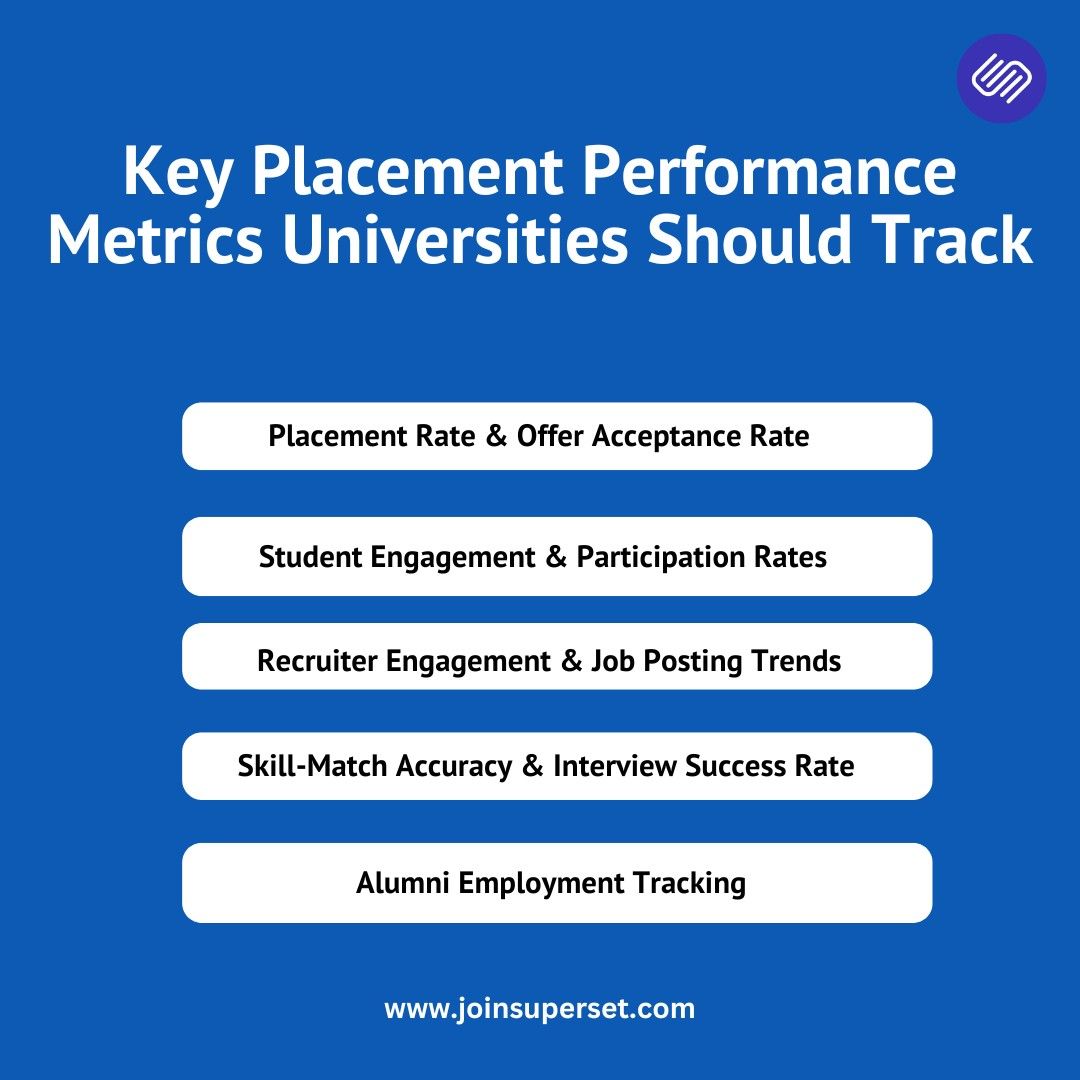In today’s fast-evolving hiring landscape, universities must embrace virtual hiring software to optimize their placement processes and improve student employment outcomes. Traditional campus hiring methods cannot often track, analyze, and refine placement strategies effectively. However, with campus hiring automation, universities can leverage data-driven insights to enhance decision-making, streamline placement operations, and boost employer-student matchmaking. Superset, a leading virtual hiring solution, empowers universities with robust placement tracking tools, enabling placement officers to monitor student progress, measure recruitment success, and improve engagement with hiring partners. This article explores how universities can harness virtual campus hiring data to refine their placement strategies and why adopting virtual hiring solutions is a game-changer for higher education institutions.
Why Data-Driven Placement Tracking Matters for Universities
Universities invest significant resources in student placements, but without data-backed insights, they often struggle to measure the success of their virtual campus hiring programs. Here’s why placement performance tracking is essential:
- Enhanced Employer Partnerships – By analyzing hiring trends, universities can strengthen relationships with recruiters and tailor their virtual hiring strategies.
- Better Student Outcomes – Tracking student progress helps universities identify skill gaps and improve career readiness programs.
- Efficient Process Optimization – Data insights streamline the virtual campus interview process, making matching students with the right employers easier.
- Transparency & Reporting – Universities can generate detailed reports showcasing placement success rates, helping attract new recruiters.
Key Placement Performance Metrics Universities Should Track
Using virtual hiring software, universities can measure the effectiveness of their placement programs through various performance indicators:

1. Placement Rate & Offer Acceptance Rate
- Measures the percentage of students who secure job offers via virtual hiring solutions.
- Helps universities assess employer demand for different courses.
2. Student Engagement & Participation Rates
- Tracks student activity during virtual campus hiring drives.
- Highlights the effectiveness of career development programs.
3. Recruiter Engagement & Job Posting Trends
- Analyzes the number of employers engaging in virtual hiring and their job posting patterns.
- Helps universities tailor hiring events to industry needs.
4. Skill-Match Accuracy & Interview Success Rate
- Evaluate how well virtual campus interviews align student competencies with job requirements.
- Identifies areas for curriculum improvement.
5. Alumni Employment Tracking
- Monitors long-term career growth trends of graduates placed via campus hiring automation.
- Provides insights into employer retention rates and job market shifts.
How Virtual Hiring Software Enhances Placement Tracking
1. Centralized Data Management for Seamless Insights
Traditional placement tracking relies on spreadsheets and manual data entry, leading to inefficiencies. Superset’s virtual hiring software offers a centralized dashboard, allowing universities to:
✔️ Access real-time placement analytics.
✔️ Track student and recruiter engagement in virtual campus hiring events.
✔️ Generate automated reports for internal assessment and employer collaboration.
2. AI-Driven Analytics for Smarter Decision-Making
With AI-powered virtual hiring solutions, universities can:
✔️ Predict hiring trends using past placement data.
✔️ Identify top recruiters and in-demand skill sets.
✔️ Provide personalized career recommendations to students based on AI-driven insights.
3. Seamless Integration with Virtual Campus Interviews
Superset’s virtual hiring software integrates directly with virtual campus interview platforms, offering:
✔️ AI-based resume screening and job matching.
✔️ Automated interview scheduling and feedback collection.
✔️ Performance tracking of students across multiple recruitment stages.
4. Customizable Reports for Employers & University Leadership
✔️ Generate detailed employer-specific reports, showcasing recruitment ROI.
✔️ Provide students with personalized placement performance reports.
✔️ Enable university leadership to refine academic and placement strategies based on data insights.
The Role of Automation in Placement Tracking
Traditional placement tracking involves manual data entry, which is time-consuming, error-prone, and inefficient. With virtual hiring software, universities can automate the placement process, reducing administrative workload and improving accuracy.
Here’s how automation enhances placement tracking:
✔️ AI-Powered Student-Job Matching – The software analyzes student skills, qualifications, and employer needs to suggest the best-fit opportunities, increasing job placement success rates.
✔️ Instant Placement Status Updates – Instead of manually checking each student’s hiring progress, placement officers receive real-time updates on applications, interview outcomes, and job offers in a centralized dashboard.
✔️ Automated Feedback Collection – Employers can submit structured interview feedback directly through the platform, enabling universities to identify skill gaps and refine training programs accordingly.
By leveraging automation, universities can track placements efficiently, improve recruiter engagement, and provide students with a seamless hiring experience.
Leveraging Real-Time Insights for Smarter Decision-Making
Real-time insights play a crucial role in campus hiring automation, allowing universities to make data-driven decisions instantly. With virtual hiring solutions, placement officers can track and analyze recruitment activities as they happen, ensuring greater efficiency and better hiring outcomes.
✔️ Monitor Ongoing Placement Drives – Universities can see which students are actively participating, how many recruiters are engaging, and where bottlenecks occur, enabling quick adjustments to maximize success.
✔️ Identify Hiring Trends – By analyzing employer preferences and high-demand job roles, universities can align their academic programs and skill-building initiatives to improve student employability.
✔️ Optimize Placement Schedules – Scheduling virtual campus interviews at the right time ensures maximum participation from students and recruiters, leading to higher placement rates and improved hiring experiences.
By leveraging real-time data, universities can continuously refine their virtual hiring strategies, improving placement efficiency and student career outcomes.
Ensuring Data Security in Virtual Hiring Software
With universities managing sensitive student and employer data, security is a top priority. A virtual hiring software like Superset ensures that all placement-related information remains confidential, secure, and compliant with global regulations.
Here’s how Superset safeguards university placement data:
✔️ Secure Data Encryption – All student records, employer details, and placement data are encrypted, preventing unauthorized access and cyber threats.
✔️ Role-Based Access Controls – Only authorized users (placement officers, students, and recruiters) can access specific data, ensuring privacy and minimizing security risks.
✔️ GDPR & Compliance Adherence – Superset follows international data protection laws, ensuring ethical data handling and student privacy while maintaining regulatory compliance.
By prioritizing data security, Superset provides universities with a trusted virtual hiring solution that protects sensitive information while streamlining the campus hiring automation process.
Why Universities Should Choose Superset’s Virtual Hiring Software
✔️ All-in-One Virtual Hiring Solution – From virtual campus interviews to employer analytics, Superset simplifies end-to-end campus hiring.
✔️ AI-Driven Insights – Smart analytics ensure data-backed decision-making for university placement cells.
✔️ Seamless Recruiter Integration – Employers can easily connect with universities, leading to better placement results.
✔️ Student-Centric Approach – Personalized career recommendations improve job-matching success.
Conclusion
In today’s competitive job market, data-driven recruitment is essential for universities to improve placement success rates. By adopting virtual hiring solutions, universities can streamline virtual campus hiring, track placement performance, and make informed decisions using real-time data. Superset’s virtual hiring software offers AI-powered analytics, automated placement tracking, and seamless recruiter engagement, enabling universities to optimize their hiring strategies. Institutions that leverage these advanced tools will enhance student employability, strengthen employer partnerships, and stay ahead in the evolving placement landscape.








